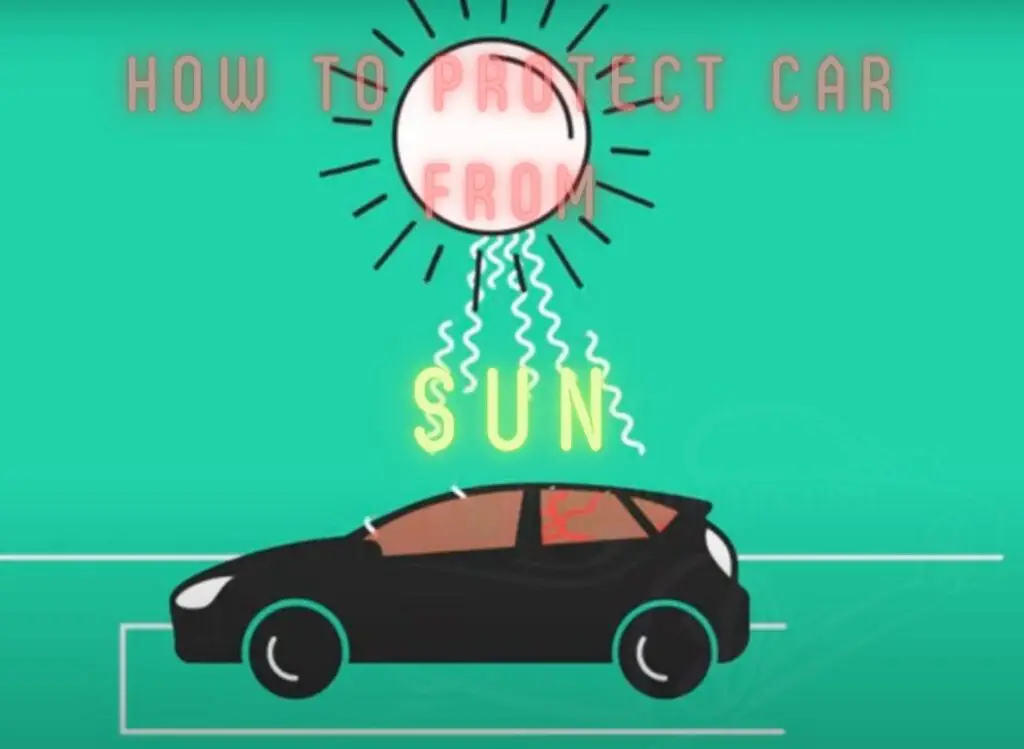
Car owners experience all sorts of problems when they take their vehicles into the sun. Sunlight continues to be a major source of oxidation to vehicles, and it can cause fading, cause paint to peel, or just cause the paint to look horrible. So how to protect car from sun?
To keep your car looking its best and maintain its value, it’s important to take steps to protect and care for it.
Sun protection for cars has been a hot topic for several years. Below, I’ve compiled everything you need to know about it, from what causes sun damage to how to prevent it.
Table of Contents
How Does the Sun Damage Car Paint?
Those who are fair of skin (like me) deal with sunburn every day, trying to find products that are safe for them to use. Sunburn is caused by exposure to ultraviolet radiation. It’s produced when sunlight passes through the atmosphere and strikes the Earth. Similar things can happen to your car’s exterior; the same cause of sunburn is also the root of the problem over time.
For those who are not fully aware, the sun’s ultraviolet rays or UV light are invisible but incredibly powerful.
Many different types of radiation are emitted by the sun, some of which include:
- Visible light (light that can be seen)
- Ultraviolet light (light that doesn’t damage the eyes)
- X-ray (which damages cells)
The exterior paint is particularly vulnerable to UV radiation, leading to fading and oxidation. Moreover, the interior components, such as the dashboard and upholstery, can suffer from cracking and discoloration.
Paint chips aren’t all bad, but they break down the molecules found in the paint and clear coat over time. It starts to become duller and less reflective than its original color, so we see less brilliance in the “color” that our eyes see. This is a well-documented fact in automotive history, but most people don’t know it.
UV light plays a vital role in the degradation of automotive paints, plastic trims, headlights, even automotive glass, tires, and wheels.
Does UV Light Cause Some Car Colors Fade Faster?
Some colors of automotive paints are indeed more susceptible to becoming damaged by ultraviolet rays. You see, every color that we see has its own wavelength that it creates. Each automotive paint color is designed to absorb all the visible light in the visual spectrum except for the one wavelength corresponding with that color.
Warning for red car owners: Red paint ‘fades’ more quickly because it has molecules more likely to break apart by ultraviolet light than the other colors.
How to Protect Car from Sun
The sun and heat can be very harmful to a car. Your car’s dash, seat, and interior are important to keep safe from the sun’s harmful rays, but your dash and seat are often overlooked. Your car’s finish and engine are also at some risk. There are plenty of reasons to be prepared year-round, including protection against the sun’s harmful rays.
How to Keep Car Exterior from Sun Damages
There are several approaches to keeping your car safe:
#1 Parking in the Shade
One of the simplest ways to shield your car from the sun is by parking it in the shade. Whenever possible, choose shaded areas such as parking garages, carports, or under trees to minimize direct exposure to the sun. This helps reduce UV rays’ intensity and protects your vehicle’s exterior and interior.
I find this valuable video with some cool hacks when parking your car.
#2 Using Car Sunshades
Car sunshades are an effective tool to shield your car’s interior from the sun’s rays. These shades are designed to block UV radiation and lower the car’s temperature. By placing a sunshade on your windshield and rear window, you can prevent the dashboard and seats from getting too hot and protect them from sun-related damage.
Studies showed that using sun shade can reduce the temperature inside the car by up to 15 degrees.

#3 Applying Window Tinting
Window tinting can significantly reduce the amount of UV radiation that enters your car. It involves applying a thin film to the windows, which blocks the sun’s harmful rays and helps keep the interior cooler. However, it’s important to check the local regulations regarding the permissible tinting levels for car windows.
#4 Regular Car Washing and Waxing
Regularly washing and waxing your car can help protect its paintwork from the sun. Washing removes dirt, dust, and other particles that can degrade the paint.
Waxing provides an additional layer of protection by creating a barrier between the paint and the sun’s rays. Use a high-quality automotive wax for optimal results.
#5 Using Car Covers
Car covers offer excellent protection against the sun’s damaging effects. They provide a physical barrier that shields your car from UV rays, bird droppings, tree sap, and other environmental contaminants. Invest in a breathable car cover that fits your vehicle properly to ensure proper airflow and prevent moisture buildup.
If you want to look at how much a car cover on Amazon is, click this link.
#6 Proper Tire Care
The sun can also affect your car’s tires, causing them to crack and deteriorate over time. Regularly clean and apply a tire dressing containing UV protectants to protect your tires. This helps prevent premature aging and keeps your tires looking fresh while providing essential protection against the sun’s harmful rays.
Besides, it is important to check the tire pressure regularly during summer. Why’s that?
When air is heated, it expands. This concept also applies to your tires, meaning the air inside them is more likely to escape during summer.
To prevent the risk of tire blowouts, it is advisable to check your tire pressure at least once a month. Doing this early in the morning when the temperatures are cooler is recommended for a more accurate reading.
#7 Maintenance of the Paintwork
The paint on your car is highly susceptible to sun damage. Regularly wash and wax your vehicle to keep it looking vibrant and prevent fading. Additionally, consider using a paint sealant or ceramic coating that provides an extra layer of protection against UV rays, oxidation, and environmental contaminants.
Read More: Discover the Best Ceramic Coating for Ultimate Vehicle Protection
For added protection, consider applying a paint protection film to vulnerable areas of your car, such as the front bumper, hood, and side mirrors. This transparent film protects against UV rays, rock chips, and scratches, preserving the paint’s quality and minimizing sun damage.
Protect Car Interior from Sunlights
#1 Use Accessories Like Windshield Sun Protector or Seat Cover
A windshield sun protector is necessary if you want to prevent wrinkles and other interior damage from the sun.
Protecting your car’s interior is one way to keep it cool and helps you prevent sun damage.
Installing a seat cover is one of the best things you can do to prevent damage to your car seats. Leather and fabric seats are the most vulnerable things in a car.
Leather seats require protection, so you should use a leather conditioner to protect them once in a while.
These accessories help in reducing direct sun exposure and prevent fading, cracking, and discoloration of the interior components. Opt for heat-resistant and absorbent materials to further protect your car’s interior from the sun’s harmful effects.
#2 Avoiding Plastic and Vinyl Cleaners
When cleaning your car’s interior, be cautious with the products you use, especially on plastic and vinyl surfaces. Some cleaners contain harsh chemicals that can accelerate sun damage and cause cracking or discoloration. Choose gentle, UV-protective cleaners specifically formulated for automotive use to maintain the integrity of these materials.
How to Protect Car Battery from Heat
Car owners must understand the most important thing about their battery: it can die if it’s not protected from extreme temperatures.
The heat speeds up chemical reactions inside the battery, causing it to discharge faster. Also, excessive heat can evaporate the battery fluid, leading to low electrolyte levels and reduced battery performance.
The failure of the battery in the winter could be a result of the damage that took place during the summer. Every time you get your battery checked with your oil change, you should also make sure to check it out carefully especially if you’re driving in summer.
Therefore, keeping your car cool is the best practice. Besides, you can use some products like battery insulation blankets. They are very helpful if you live in high-temperature areas.
Battery insulation blankets are specially designed to provide thermal protection to car batteries. These blankets help maintain a stable temperature and prevent heat transfer to the battery. By wrapping the battery with an insulation blanket, you can reduce the risk of overheating and extend its lifespan.
The Role of Car Detailing
Overall, protecting the car inside out from the sun is crucial. That’s why each car owner should know some basic car detailing techniques.
Regular car detailing not only keeps your vehicle looking its best but also helps in preserving its condition.
Detailing involves thoroughly cleaning, polishing, and protecting exterior and interior surfaces. Professional detailers use specialized products that rejuvenate and safeguard your car against sun damage.
Check out: Do You Know A Comprehensive Car Detailing Checklist?
Useful Tips To Protect Your Car From The Sun and Heat

If you’re a driver, you may want to check the temperature inside your car more often. It could easily reach the temperature of frying an egg in just a few hours. If you need to leave your car outside for a long time, make sure to protect it with a cover.
Cars are not designed to withstand extreme temperatures.
Whether it’s a new or used car, both cars need care and protection against the sun and heat.
A heatwave might not be the first thing to come to your mind when thinking about a car. But it may be a good idea to check the engine and the battery before you start your next trip. When the sun becomes hyperactive, it causes sunburns and freckles.
Cars don’t just use UV protection, they also use a variety of materials to prevent heat and harm. You can do the same for your car by using the right products to protect it.
And since we care for our cars just like we care for ourselves, it makes complete sense to prepare ahead for the scorching heat of summer.
How to Protect Car From Sun in Open Parking

To protect your car from the sun in an open parking area, there are things you can do on the spot and things you should equip with your vehicle:
What you can do at the parking is:
- Seek shade: Park your vehicle in shaded areas, such as under trees, canopies, or covered parking structures. This helps minimize direct exposure to the sun’s rays.
- Use a car cover: Invest in a high-quality car cover designed to block UV rays and provide protection against heat. Make sure the cover fits your vehicle properly to ensure full coverage.
- Use a windshield sun protector: When parking, use a windshield sunshade or sun protector to minimize heat buildup inside the vehicle. This accessory blocks the sun’s rays and helps keep the cabin cooler.
What you can install for your car to protect it in open parking areas is:
- Apply window tint: Consider applying window tint to your car’s windows, as it can significantly reduce UV radiation and heat transmission. Ensure that the tint complies with local laws and regulations.
- Regularly wax and polish: Apply a high-quality automotive wax or polish to your car’s exterior. This creates a protective layer that helps shield the paint from sun damage, including fading and oxidation.
- Consider ceramic coatings: Opt for ceramic coatings for your car’s exterior. These coatings provide long-lasting protection against UV rays, heat, and environmental contaminants, while also enhancing the paint’s shine and durability.
Frequently Asked Questions
1. Should I park my car under a tree to protect it from the sun?
Parking under a tree can provide shade, but it’s important to consider the risks of tree sap, bird droppings, and falling branches. If you park under a tree, use a car cover for added protection.
2. How often should I wash and wax my car to protect it from the sun?
Washing your car every two weeks and applying wax every three months is recommended. However, the frequency may vary depending on your location and weather conditions.
3. Is it necessary to use UV-protective cleaners for my car’s interior?
Using UV-protective cleaners is not mandatory, but it helps prevent sun damage and preserve the quality of plastic and vinyl surfaces in your car’s interior over time.
Regular cleaning with gentle, UV-protective cleaners is highly recommended for long-term protection.
4. Can window tinting damage my car’s windows?
When installed properly by professionals, window tinting does not damage car windows. However, it’s crucial to comply with local regulations and choose a reputable installer to ensure the tinting is done correctly.
5. How long does paint protection film last?
The lifespan of paint protection film varies depending on factors such as the quality of the film and how well it is maintained. Generally, it lasts five to ten years, providing long-lasting protection for your car’s paint.
Wrap Up
I bet you have had many ideas on how to protect car from sun now. Protecting your car from the sun is essential to preserve its appearance, value, and overall condition. You can significantly reduce sun damage by following the tips mentioned in this article.
Remember to take preventive measures for tires, paintwork, and windows, and consider professional services like paint protection film and car detailing. By implementing these strategies, you can enjoy a well-protected car that maintains its beauty for years to come.
Further Reading:
- Heat, Autos, and Safety
- Heat exposure in an enclosed automobile
- How to Cool a Hot Car as Quickly as Possible
Hi everyone, My name is Ollie Barker.
As a seasoned auto expert I have 25 years of experience working in repair and detailing shops. I love to share my tips & tricks to all car lovers, so that’s why I’m here at Automotive Gearz publishing my content, sharing my passion. Also, I’ve been giving my recommendations on which products are the best to have on the market. I always thought it was hard to pick the right part, so hopefully I can make that a bit easier for you.
Hope you enjoy your time on my little blog!







